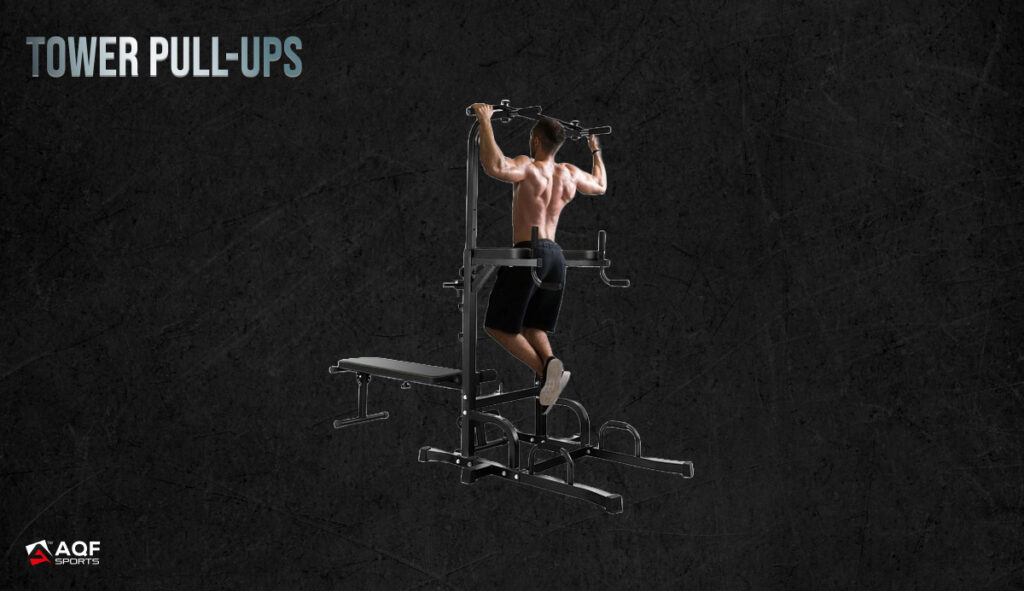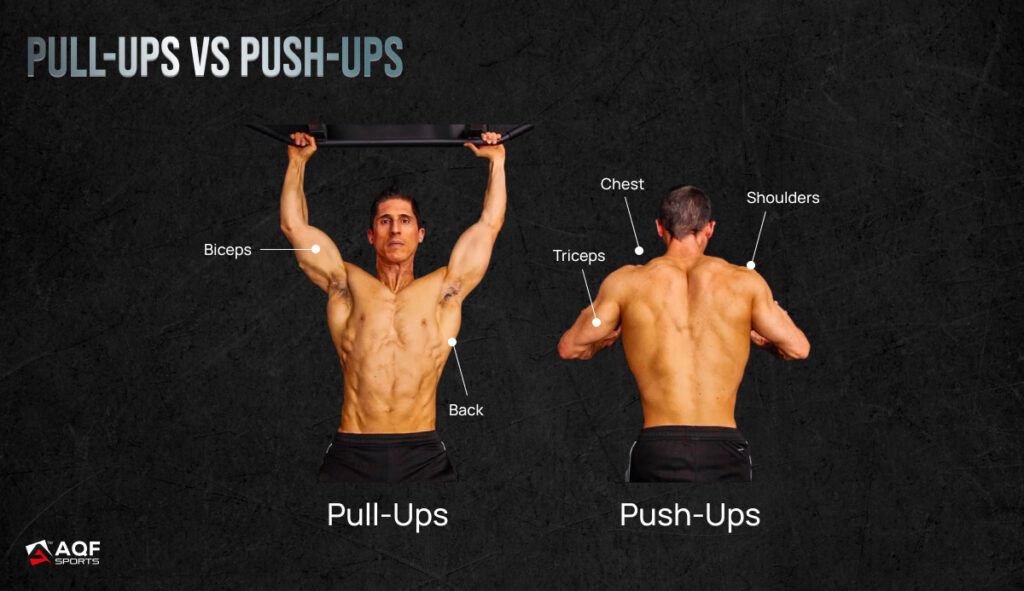Do Pull Ups Work Triceps? [Sports Science Reveals the Answer]
![Do Pull Ups Work Triceps? [Sports Science Reveals the Answer]](https://blog.aqfsports.com/wp-content/uploads/2023/08/image-23.jpeg)
Curious about whether pull-ups really do a number on your triceps? Pullups exercise is great for building upper body strength and getting that nice V-shaped look. But do pull ups work triceps?
Pull-ups mainly work your back muscles and biceps – not so much your triceps.
Tricep muscles act as stabilizers during pullups. They are involved during lowering (eccentric) portion of the pull up and they also flex your elbow.
Muscle Activation During Pull-ups (Pronated Grip), Chin-ups (Supinated Grip) and Perfect Pull-ups
Source: https://www.sci-sport.com/en/articles/img/a10705.png

Do Pull Ups Make Triceps Bigger?
When you do pull-ups, your back muscles (called latissimus dorsi) and the biceps (Biceps Brachii) in your arms do most of the heavy lifting. Your shoulders and core muscles also get in on the action.
The bicep muscles are located on the front of your upper arm. Biceps flex to bend your forearm at elbow and extend to straighten your forearm during pullups.
The tricep muscles have three heads: the long head, the lateral head, and the medial head.
During pull-ups, the triceps are mainly activated to stabilize your body and keep it steady as you pull yourself up.
However, tricep’s don’t really contribute to the actual pulling motion and their involvement is quite minimal compared to the biceps.
Tricep dips, close-grip bench presses (where your hands are close together), and tricep extensions are better options for working out your biceps.
Suggested Read: Bulking Bicep Workout And Meal Recommendations
Pro Tip: Weighted Pull-Ups (Add Resistance to Engage Your Triceps)
Use a weight belt or vest to increase weight, instability and exercise resistance of the overall pullup.
This can help engage your triceps more, especially if you focus on controlled and deliberate movements.
How much do pull ups work triceps?
During pull-ups, your back muscles and biceps are the star muscles. They do the heavy lifting work and pull you up to the bar. Your triceps, on the other hand, play a supporting role. They keep your body steady and balanced for a smooth workout.
Scientifically speaking, studies and biomechanical show that triceps muscle activation is considerably lower compared to your back and biceps muscles during pullups. [1]
Research indicates that the triceps play more of a supportive role in maintaining your body’s balance and posture during the exercise.
If your goal is to give your triceps a more substantial workout, it’s recommended to focus on exercises that involve higher level of instability. [2]
Tricep dips, tricep extensions, and close-grip bench presses require more stability and activate triceps more than pull up exercises.
Which Pull Up Combinations are best for triceps?
When you’re looking to give your triceps a bit more attention during your pull-up routine, you can try incorporating specific variations to increase instability and muscle resistance.
Here are some pull-up combinations that can be effective for targeting your triceps:
Close-Grip Pull-Ups
For this variation, bring your hands closer together on the bar, with your palms facing you.
This hand placement shifts some of the focus onto your triceps and they tend to work harder to assist in the pulling motion.

Neutral-Grip Pull-Ups
Use parallel bars or handles that allow for a neutral grip (palms facing each other).
This grip engages the triceps more as you pull yourself. It is a better tricep workout compared to the standard pull-up.

Mixed-Grip Pull-Ups
Try alternating your hand placement for each set.
For example, on one set, use an overhand grip (palms facing away) and on the next set, use an underhand grip (palms facing you).
This variation can help engage your triceps differently while still targeting your back and biceps.
Related Read: How To Do Bicep Curls Properly?

Towel Pull-Ups
Hang towels over the pull-up bar and grip the towels instead of the bar.
This variation adds instability and requires more effort from your triceps to stabilize your body during the pull-up.

Pull-ups Vs Push-Ups – Which One work Triceps More Than Biceps?
Push-Ups
Push-ups are notably effective in engaging the triceps. When you lower your body towards the ground and then push it back up, the main force required is elbow extension, which prominently involves the triceps.
A study published in the “Journal of Physical Therapy Science” (2015) [3] investigated muscle activation during various push-up variations and found that triceps activation was particularly pronounced in standard and close-grip push-ups.

Pull-Ups
In the case of pull-ups, the focus is primarily on the back and biceps muscles. The main pulling movement engages the muscles in your back, especially the latissimus dorsi, and the biceps. While the triceps contribute to stabilizing your body during the exercise, they are not the central muscles being targeted.
A study published in the “Journal of Electromyography and Kinesiology” (2019) [4] examined muscle activation and confirmed the significant involvement of the latissimus dorsi and biceps brachii and omparatively lower triceps activation during pull-ups.
Learn More: Chin Ups vs Pull Ups: Clash of the Titans
Final Verdict
Pull-Ups are a compound exercise which primarily target your back muscles and biceps brachii. Triceps play a stabilizing role during eccentric portion of the pull-ups. Incorporating standard pull-ups and push-ups into your workout routine is a great way to workout all your arm muscles for bulking and strength training.
Explore Related Topics:
- How to Get Tougher With 9 Effective Strength Training Exercises
- Understanding Different Types of Gym Equipment: A Comprehensive Guide
- The 7 Best Back Exercises to Strengthen Back Muscles
References:
[1] Anderson, K., & Behm, D. G. (2005). The Impact of Instability Resistance Training on Balance and Stability. Sports Medicine, 35(1), 43–53. https://doi.org/10.2165/00007256-200535010-00004
[2] Anderson, K. G., & Behm, D. G. (2004). Maintenance of EMG Activity and Loss of Force Output With Instability. The Journal of Strength & Conditioning Research, 18(3), 637. https://journals.lww.com/nsca-jscr/Fulltext/2004/08000/Maintenance_of_EMG_Activity_and_Loss_of_Force.43.aspx
[3] Ho, A. J., Cudlip, A. C., Ribeiro, D. C., & Dickerson, C. R. (2019). Examining upper extremity muscle demand during selected push-up variants. Journal of Electromyography and Kinesiology, 44, 165–172. https://doi.org/10.1016/j.jelekin.2018.12.008
[4] Beaudette, S. M., Unni, R., & Brown, S. H. M. (2014). Electromyographic assessment of isometric and dynamic activation characteristics of the latissimus dorsi muscle. Journal of Electromyography and Kinesiology, 24(3), 430–436. https://doi.org/10.1016/j.jelekin.2014.03.006






